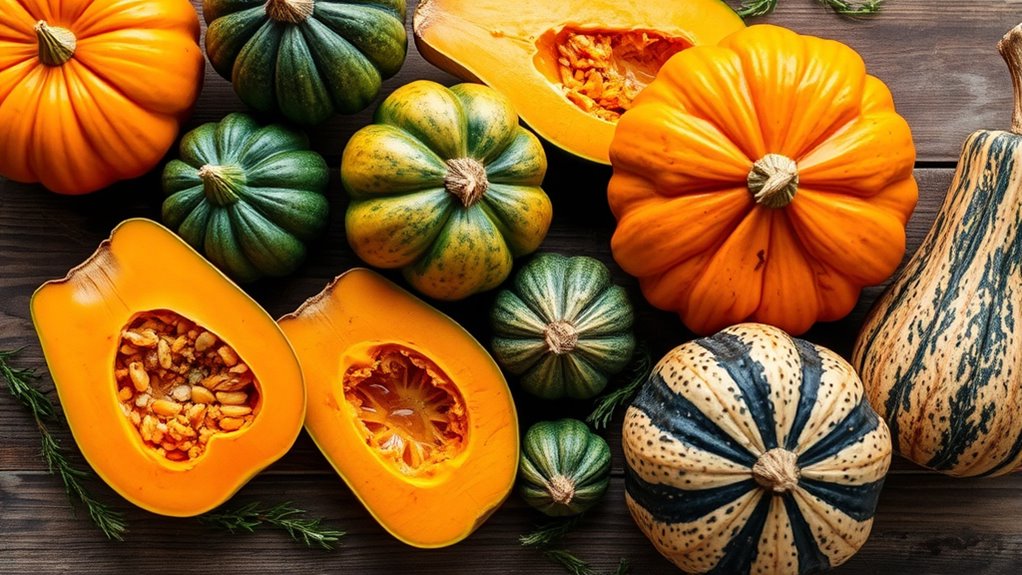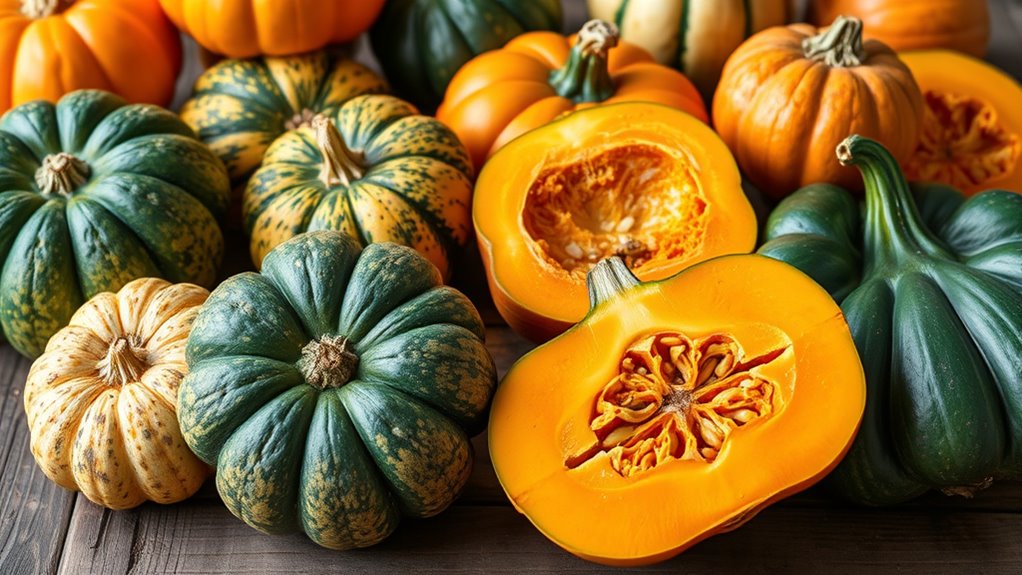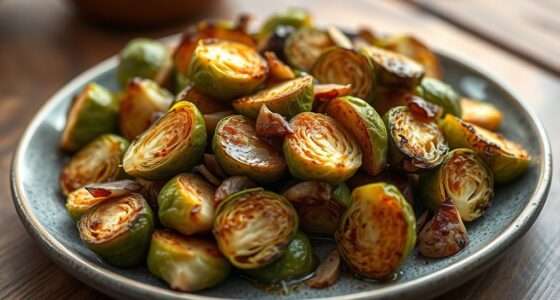To create a tasty medley of winter squashes, choose a variety like butternut, acorn, kabocha, and delicata for color and flavor. Wash them well, then cut into halves or cubes. Toss with olive oil, salt, and herbs, and roast at 400°F for 30-45 minutes, turning halfway. Combining these varieties enhances both look and taste. Keep exploring for more tips on balancing flavors and preparation techniques to make your dish shine.
Key Takeaways
- Select a variety of winter squashes like butternut, acorn, and kabocha for diverse flavors and textures.
- Wash and cut squashes into uniform pieces for even roasting, or roast whole small varieties.
- Toss squash pieces with olive oil, salt, herbs, and spices before roasting at 400°F (200°C) for 30-45 minutes.
- Mix different squash types on a baking sheet to create a colorful, flavorful medley with caramelized edges.
- Incorporate roasted squash into salads, soups, or stuffing to highlight seasonal ingredients and enhance flavor.

A medley of winter squashes offers a vibrant array of flavors, colors, and textures that can elevate any seasonal meal. When you explore different squash varieties, you reveal a world of culinary possibilities, especially since these seasonal ingredients are at their peak during fall and winter. Each squash type brings its own unique taste and consistency, making your dishes more diverse and exciting. But before you start cooking, it’s essential to understand the characteristics of each variety to maximize their potential. For example, butternut squash has a sweet, nutty flavor and smooth flesh, perfect for purees or roasting. Acorn squash offers a slightly bitter edge with a dense, fibrous texture that holds up well in hearty dishes. Kabocha, often called Japanese pumpkin, is sweet and velvety, ideal for roasting or stuffing. Delicata squash, with its thin, edible skin and sweet flavor, is excellent for roasting whole or slicing into salads. Knowing these differences allows you to select the right squash for your recipe, ensuring you get the best flavor and texture.
Additionally, understanding the nutritional benefits of winter squash can help you incorporate these healthy ingredients into your diet for added health benefits. When preparing your squash varieties, remember that seasonal ingredients like winter squash are best enjoyed when fresh and in season. Their flavors are most vibrant, and they tend to be more affordable and accessible. To maximize their flavor, always wash the squash thoroughly before cutting. You might find that some varieties, such as delicata or acorn, can be roasted whole if small enough or sliced into uniform pieces for even cooking. Roasting is one of the easiest and most flavorful ways to prepare winter squash. Simply cut the squash into halves or cubes, toss with a bit of olive oil, salt, and your favorite herbs or spices, then roast at 400°F (200°C) until tender and caramelized—usually 30 to 45 minutes, depending on the size of the pieces. Turning the squash halfway through helps achieve an even, golden-brown surface.
Don’t shy away from mixing different squash varieties for a colorful, textured medley. Combining sweet butternut with the earthiness of kabocha or the delicate flavor of delicata can create a beautiful dish full of contrast. These seasonal ingredients lend themselves well to roasting, but you can also incorporate them into soups, stews, or stuffing recipes. The key is to balance flavors and textures, allowing each squash to shine. Remember, since they are at their peak during colder months, using a variety of winter squashes not only enhances your dish’s flavor but also celebrates the bounty of the season. With a little preparation and creativity, your medley of winter squashes will become a highlight of your seasonal cooking.
Frequently Asked Questions
How Long Can Roasted Winter Squashes Be Stored?
Roasted winter squashes can be stored in the refrigerator for up to 3 to 5 days. To maximize their storage duration, transfer the leftovers to an airtight container and refrigerate promptly. For best results, follow refrigeration tips such as letting the squash cool completely before storing and keeping it at a consistent temperature. If you want to keep them longer, consider freezing, which extends their shelf life to several months.
Can I Substitute Winter Squashes in Recipes?
Think of your recipe as a symphony, and each squash as a different instrument. You can substitute winter squashes, like butternut for acorn, to create new flavor melodies. Just consider the flavor substitutions and texture differences; some squashes may need adjustments in cooking time or seasoning. Experiment confidently, knowing that your adaptability allows you to craft personalized recipe adaptations while maintaining harmony in your dish.
Are There Allergy Concerns With Certain Squash Varieties?
Yes, you should be aware of allergy prevention when consuming winter squashes, as some people might experience allergic reactions. Cross reactivity concerns are common because certain squash varieties, like pumpkins and zucchinis, belong to the same plant family, which can trigger allergies if you’re sensitive. Always test a small amount first and consult with an allergist if you’re unsure, especially if you have known food allergies.
What Are Some Creative Uses for Leftover Roasted Squash?
Imagine you’re in a culinary time machine, transforming your leftover roasted squash into new delights. You can blend it into a creamy squash smoothie for mornings or stir it into savory squash pancakes for brunch. Spread it on toast with a touch of honey, add it to soups for extra flavor, or mix it into pasta sauces. Your leftover squash is versatile—get creative and enjoy its comforting, sweet, and savory flavors!
How Do I Select the Freshest Winter Squashes at the Market?
To pick the freshest winter squashes at the market, look for seasonal squash varieties with firm, heavy skins that feel solid when you touch them. Avoid squashes with cuts, soft spots, or blemishes. Use market selection tips like inspecting the stem—fresh ones have dry, corky stems. Choose squashes that feel heavy for their size, indicating they’re ripe and full of flavor.
Conclusion
Now that you’ve explored these delicious winter squash recipes and roasting tips, you’re ready to transform simple ingredients into a vibrant, hearty meal. Remember, each squash holds its own unique flavor—like a symphony waiting to be played. By experimenting and embracing their differences, you’ll turn everyday ingredients into a masterpiece. So don’t hold back—let your kitchen be the stage, and let these squashes sing their seasonal song. Your culinary adventure awaits!









